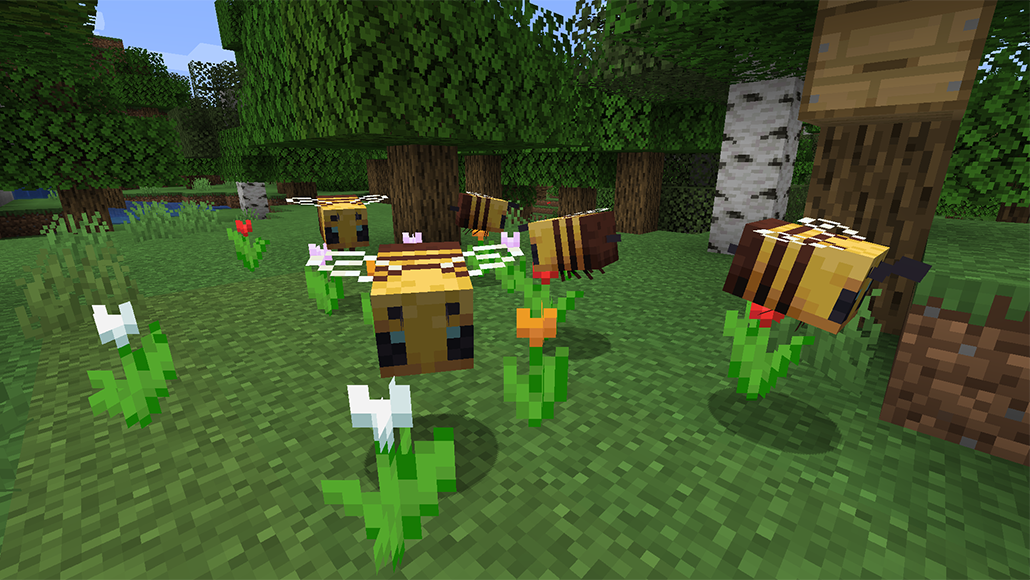Minecraft’s big bees don’t exist, but giant insects once did
Big insects need large wings and a lot of energy to flap them

Blocky bees buzz about in the world of Minecraft.
Jeevan Richmonds
Share this:
- Share via email (Opens in new window) Email
- Click to share on Facebook (Opens in new window) Facebook
- Click to share on X (Opens in new window) X
- Click to share on Pinterest (Opens in new window) Pinterest
- Click to share on Reddit (Opens in new window) Reddit
- Share to Google Classroom (Opens in new window) Google Classroom
- Click to print (Opens in new window) Print
Big bees buzz in Minecraft. In our world, blocky bees might starve and be stuck on the ground. Yet long ago, giant insects did roam our planet.
Visit a flower forest in the game Minecraft and you may stumble across big, blocky bees searching for blooms. In real-world terms, those boxy behemoths measure a whopping 70 centimeters (28 inches) long. They’d be similar in size to a common raven. And they’d dwarf any insects alive today.
The world’s biggest modern bees, found in Indonesia, max out at around 4 centimeters (1.6 inches). But shockingly large insects aren’t much of a stretch. You’d just need to go back in time. A very long time ago, gargantuan grasshoppers and massive mayflies cruised the planet.
The largest known insects that ever lived were ancient relatives of dragonflies. Belonging to the genus Meganeura, they lived roughly 300 million years ago. These behemoths had wings spanning around 0.6 meter (2 feet). (That’s similar to the wingspan of a pigeon.)
Other than size, these creatures would have looked like modern dragonflies, says Matthew Clapham. He’s a paleontologist at the University of California Santa Cruz. These ancient insects were predators, he says, and likely ate other insects.
Back 220 million years ago, giant grasshoppers flitted about. They had wingspans stretching 15 to 20 centimeters (6 to 8 inches), notes Clapham. That’s similar to the wingspan of a house wren. Large relatives of mayflies also moved through the air. Today, those insects are known for their short lifespans. Their ancient relatives’ wings spanned some 20 or 25 centimeters, about three-fourths that of today’s house sparrows. There even were massive millipedes and roaches.
Scientists think such colossal creepy crawlies evolved because of a bump in the amount of oxygen in the air. The Carboniferous period was from 300 million to 250 million years ago. Back then, oxygen levels reached around 30 percent, scientists estimate. That’s a lot higher than the 21 percent in air today. Animals require oxygen for metabolism, the chemical reactions that power their bodies. Bigger creatures tend to use more oxygen. So extra oxygen in the atmosphere may have provided the conditions for large insects to evolve.
The first insects appeared in fossils from around 320 million or 330 million years ago. They started out pretty big and hit their peak size quickly, Clapham says. Since then, insect sizes have mostly gone downhill.
Clapham and his colleagues use computer models to investigate the prehistoric atmosphere. Earth’s oxygen levels relate to the balance of photosynthesis and decay. Plants use sunlight and carbon dioxide to fuel their growth. This process add oxygen to the air. Decaying matter consumes it. The scientists’ work suggests oxygen levels started dropping around 260 million years ago. The levels then fluctuated over time. For much of insects’ history, oxygen levels and wing sizes of the biggest insects seem to have changed together, Clapham says. With falling oxygen, wingspans shrank. Upticks in oxygen corresponded with bigger wings. But then around 100 million to 150 million years ago, “the two seem to go in opposite directions.”
What happened? Birds first emerged at that time, Clapham says. There were now more flying creatures. Birds could prey on insects and potentially compete with them for food, he notes.
Even when oxygen levels were high, not all insects were huge. Bees, which appeared about 100 million years ago, have stayed roughly the same size. Ecology probably explains this, Clapham says. “Bees have to pollinate flowers. And if flowers are not getting any bigger, then bees can’t really get any bigger.”
Taking to the air as a square
Minecraft’s giant bees have one big strike against them — their body shape. “[A] blocky body is not very aerodynamic,” says Stacey Combes. Combes is a biologist who studies insect flight at the University of California, Davis.
An aerodynamic object allows air to flow smoothly around it. But blocky things, like those bees, tend to be slowed by drag, she says. Drag is a force that resists motion.
Combes demonstrates how air flows around differently shaped objects for her students. She places Matchbox cars in a wind tunnel and watches the air move. Around a bitty Batmobile, layers of air called streamlines move smoothly. But a mini Mystery Machine, the boxy van used by Scooby Doo’s gang, creates “this swirly, messy, ugly wake behind it,” Combes says. You’d get something similar with a Minecraft bee.
It takes more energy to move a blocky object than a more streamlined one. And flight already requires a lot of energy. “Flight is the most expensive way to move … way more expensive than swimming and walking and running,” Combes explains. These bees would need big wings that require a lot of energy to flap.
To get enough energy, Minecraft bees would need a lot of nectar, Combes says. Adult bees typically consume only sugar. The pollen they collect is for their young. So “these guys would need giant flowers and tons of sugar water,” she says. “Maybe they could drink soda.”
Big bees buzz in Minecraft. In our world, blocky bees might starve and be stuck on the ground. Yet long ago, giant insects did roam our planet.







